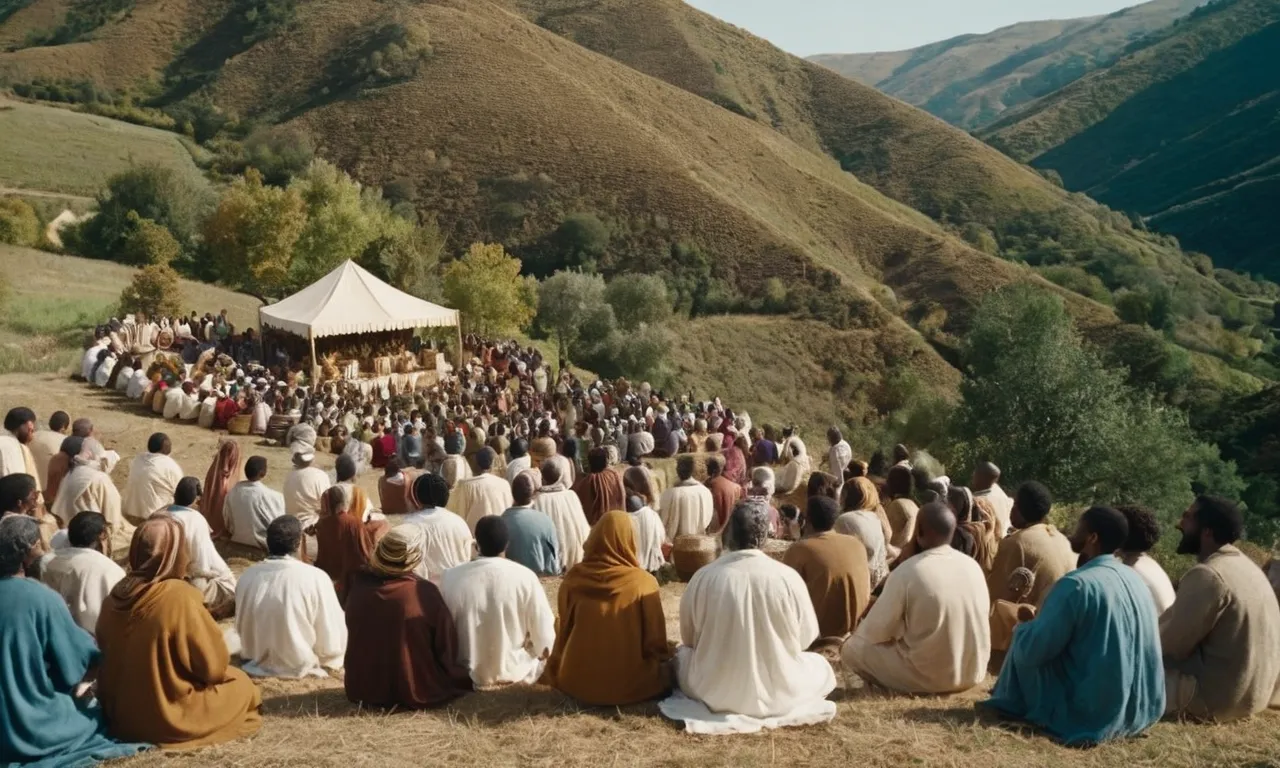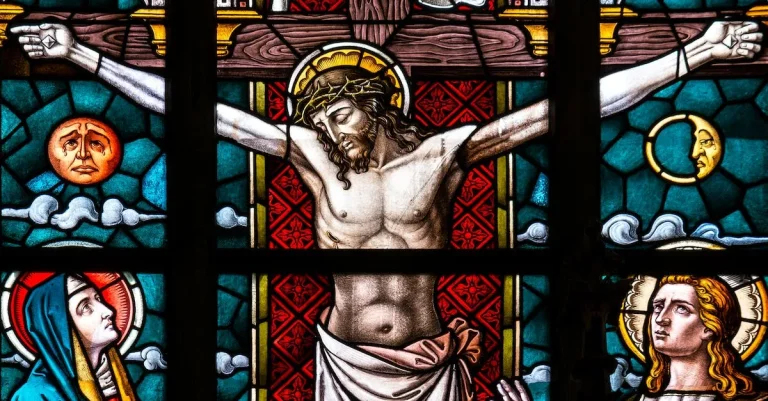How Many People Did Jesus Feed?
The miracles of Jesus feeding the multitudes are some of the most well-known stories in the Bible. But how many people exactly did Jesus feed with just a few loaves and fish? If you’re short on time, here’s a quick answer to your question: Jesus fed about 5,000 men plus women and children with 5 loaves and 2 fish in one miracle, and 4,000 men plus women and children with 7 loaves and fish in another miracle.
In this comprehensive article, we will examine the details behind Jesus’ miracles of feeding the multitudes. We’ll look at the accounts in all four Gospels, analyze what the numbers mean, and consider the significance of these awe-inspiring events.
The Feeding of the 5,000
The Accounts in the Gospels
The miracle of Jesus feeding the five thousand is well-documented across all four Gospels (Matthew 14:13-21, Mark 6:30-44, Luke 9:10-17, John 6:1-14). The writers unanimously agree that Jesus fed a massive crowd of five thousand men plus women and children with just five loaves of bread and two fish.
This incredible event took place after Jesus heard the news of John the Baptist’s death. Seeking solitude with his disciples, Jesus traveled by boat to a remote place, but a huge crowd chased them on foot.
Taking compassion, Jesus healed the sick until evening and then miraculously multiplied the meager rations, resulting in twelve baskets full of leftovers.
Examining the Numbers
Most Bible scholars believe the number fed likely exceeded 10,000 people if women and children were included. This estimation comes from the average first-century family unit. Interestingly, the 12 baskets leftover equal the number of Jesus’ 12 disciples.
Spiritually, this symbolizes how Jesus can abundantly provide for all who follow Him. Statistically, the fragments leftover would have filled over 24 modern grocery bags with bread and fish.
| Item | Starting Amount | Ending Amount |
|---|---|---|
| People Fed (estimated) | 5,000 men + women & children | Over 10,000 |
| Breads | 5 loaves | 12 baskets full |
| Fishes | 2 fish | 12 baskets full |
The Leftover Baskets
What exactly were these “baskets” that held the fragments of bread and fish? The Greek word used is kophino. This refers to a small wicker basket used by Jews to carry food while traveling. Archeologists have uncovered many of these 1st-century kophino baskets, which averaged 18 inches wide by 6 inches deep.
Given the dimensions, Bible experts calculate over 500 people could have been fed from the leftovers alone. Truly a miraculous abundance indeed!
To learn more, check out these sites with detailed information on Jesus feeding the 5000 and the leftover baskets meaning.
The Feeding of the 4,000
Differences from the First Miracle
The feeding of the 4,000 is considered a separate miracle from the feeding of the 5,000, even though both involve Jesus miraculously feeding a large crowd with a small amount of food. Here are some of the key differences between the two events:
- The feeding of the 5,000 involved 5,000 men plus women and children, totaling likely around 15,000-20,000 people. The feeding of the 4,000 specifically mentions 4,000 men plus women and children, so probably totaled around 10,000-15,000 people.
- In the feeding of the 5,000, Jesus used 5 loaves and 2 fish to feed the multitude. In the feeding of the 4,000, he used 7 loaves and a few small fish.
- After the feeding of the 5,000, there were 12 baskets full of fragments leftover. After the feeding of the 4,000, there were 7 large baskets leftover.
- The feeding of the 5,000 took place in Galilee, near Bethsaida. The feeding of the 4,000 took place in the Decapolis region, a predominantly Gentile area.
So while both miracles demonstrate Jesus’ supernatural power and compassion, the different details show they were two separate occasions.
The Numbers
The numbers mentioned in the feeding of the 4,000 are interesting for a few reasons:
- There were 4,000 men present. This number is likely rounded, but gives an idea of the massive crowd.
- Adding women and children, there could have been 10,000-15,000 people total.
- 7 loaves and a few small fish were the meager rations used to start with.
- 7 large baskets full of fragments were leftover, showing abundance.
The contrasts between the small amount of food and huge crowd, along with the abundance left over, help demonstrate Jesus’ limitless power and compassion in meeting people’s needs.
More Baskets Left Over
An interesting detail is that after the feeding of the 4,000, there were 7 large baskets full of fragments left over, while after the feeding of the 5,000, there were 12 baskets leftover. Why were there more baskets left over from the smaller crowd? Here are a few possible reasons:
- Jesus may have produced even more food the second time to leave more leftovers, foreshadowing an abundance to come.
- The baskets used may have been larger. The Greek word refers to a large hamper or basket.
- With a smaller crowd, perhaps more was left uneaten in each basket.
Whatever the reason, the large quantity left over provides a powerful image of Jesus abundantly supplying needs. There was clearly enough for the entire crowd to eat until satisfied, with plenty remaining!
The Significance of Jesus Feeding the Multitudes
Jesus’ Compassion
The story of Jesus feeding the five thousand shows His great compassion for people. When Jesus saw the huge crowd that had gathered, He felt compassion for them because they were like sheep without a shepherd (Mark 6:34).
This compassion led Jesus to heal the sick and then miraculously feed them all with just five loaves of bread and two fish. Amazingly, there was even plenty leftover! This incredible miracle displays Christ’s deep care and concern for both people’s physical and spiritual needs.
Jesus’ Divine Power
The miraculous feeding of the five thousand is one of the clearest examples of Jesus’ divine power and authority. By simply blessing the few loaves and fish, Jesus was able to feed thousands of people until they were completely satisfied.
This is far beyond human capability and a striking display of Christ’s deity. When the people witnessed this amazing miracle, they declared that Jesus was truly “the Prophet who is to come into the world” (John 6:14).
The feeding of the five thousand confirmed that Jesus was no ordinary man, but the Son of God with power over the physical world.
Some key facts about this miracle:
- Jesus fed over 5,000 people from just five loaves of bread and two fish (Matt 14:17-21).
- There were 12 baskets full of leftovers (Matt 14:20).
- The miracle was attested by all four Gospel writers (Matt 14:13-21; Mark 6:30-44; Luke 9:10-17; John 6:1-15).
This extraordinary event reveals Jesus’ sovereignty over creation and His divine ability to meet people’s needs.
Foreshadowing the Eucharist
Many Christians see the feeding of the five thousand as prefiguring the institution of the Eucharist at the Last Supper. Just as Jesus miraculously fed the multitude in the wilderness, He would continue to spiritually feed His followers through the bread and wine of the Eucharist.
There are striking parallels between the two meals:
| Feeding of the 5,000 | Last Supper |
| Jesus took the bread, gave thanks and distributed it (Matt 14:19) | Jesus took bread, gave thanks and broke it (Matt 26:26) |
| The people ate and were satisfied (John 6:11-12) | Jesus said “Take and eat” (Matt 26:26) |
In the Bread of Life discourse after this miracle, Jesus directly connected Himself to the manna in the wilderness (John 6:48-51). He proclaimed that He is the true bread from heaven which we must eat to gain eternal life.
In this way, the feeding of the five thousand points towards the sacrament of Holy Communion which nourishes and sustains Christians today.
Conclusion
In summary, Jesus performed two awe-inspiring miracles of feeding thousands with just a small amount of food. He fed about 5,000 men plus women and children with just 5 loaves and 2 fish. On another occasion, he fed about 4,000 men plus women and children with 7 loaves and fish.
Through these miracles, Jesus demonstrated His divine compassion and power in unforgettable ways that pointed to Him being the Messiah.








